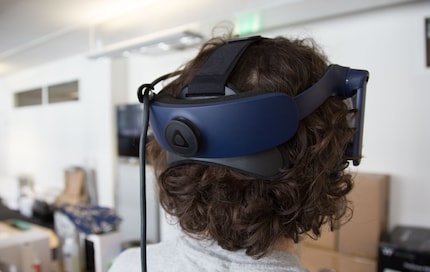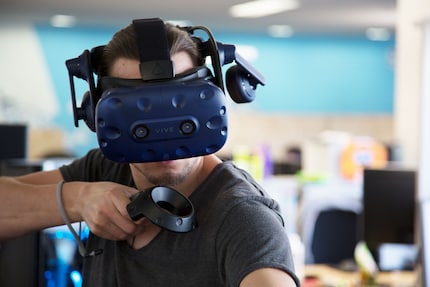
HTC Vive Pro: This pixel splendour will cost you dearly
More pixels, more comfort, more money. Unfortunately, you don't get the latter with the HTC Vive Pro, you have to fork out. HTC and Valve charge a hefty sum for their VR upgrade. Is the investment worth it?
Although not version 2.0, the new HTC Vive Pro is a clear leap in development. It was obviously still a little too early for a completely revised model, but many VR fans have probably been eagerly awaiting this upgrade. Unfortunately, as with the first model, early adopters will have to dig deep into their pockets.
The Vive Pro is compatible with the existing Vive controllers and the Lighthouse tracking system. However, the Linkbox has different connections. Therefore, you cannot continue to use your existing cables. The Linkbox is connected to the Vive with a proprietary cable and connected to the PC on the other side via mini display port and a USB 3.0 Type A. It also requires power. It also requires power. That's at least two cables less.
More comfort
The design changes are a welcome upgrade overall. However, you will still have a crushed face after longer gaming sessions. The increased weight (555 g instead of 470 g) is also noticeable at some point. I don't get anywhere near gaming times like sitting in front of the PC with it.
Last but not least, HTC has given the Vive Pro two stereoscopic front cameras. The predecessor had one such camera, which served as a window to the outside world. However, the delay was so long that it was better to simply remove the headset. Apart from that, there were practically no applications that made use of the camera and, unlike Microsoft's mixed reality headsets, they are not used for tracking. So you still need the Lighthouse satellites.
Let's play
The increased resolution is immediately noticeable in practically all applications. Although the image is still miles away from the razor-sharp appearance of a PC monitor, it is also almost as far away from the grainy look of the old VR generation. Text is clearer to read and details are generally much easier to make out. "Doom VR" is a good example of this, which can be played for longer with the Vive Pro.
"Superhot VR", one of the best VR games ever, makes shots more clearly recognisable thanks to the higher resolution and allows the minimalist polygon-style graphics to come into their own even better. Incidentally, it took 10 seconds for my colleague Martin Jud to knock over a box and also knock over the monitor behind it. This was more down to his overzealousness than his new-found realism, but I still wanted to mention it ;).
"Thumper" is another parade title that literally starts to shine in 2880×1660 pixels. The spaced-out design really comes into its own and the rhythm action game becomes even more of a trip.
Conclusion: A lot of money per pixel
Note: The first batch of the Vive Pro is already sold out in our country. However, the next batch should arrive soon. After that, the Vive Pro will only be available as a bundle.
As a child, I wasn't allowed to have any consoles. It was only with the arrival of the family's 486 PC that the magical world of gaming opened up to me. Today, I'm overcompensating accordingly. Only a lack of time and money prevents me from trying out every game there is and decorating my shelf with rare retro consoles.





